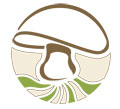Appleslade
Mon 10 Dec 2007
Field event ID HF0729
OS Grid areas: SU1809
Weather: After a week of frosts and rain the day itself was overcast with light rain.
New Records:
New to Britain: Mollisia subglobosa
New to Hants: Hyphoderma cremeoalbum
New to HFRG: Piloderma byssinum, Psathyrella laevissima
Report: Fourteen members gathered in light rain and set off at a cracking pace, for forayers that is, to make sure we returned in time for the Christmas dinner at Red Shoot Inn. On the edge of the carpark we viewed a cluster of fruitbodies growing on a beech stump and without much thought muttered Psathyrella piluliformis. Our visitor from Surrey, Barrie Hughes, picked up a specimen and asked us if we were sure this was not Psathyrella laevissima and was greeted with a blank look from the group. This was a new name for us dispite being well recorded in the New Forest! It is smaller and has more crowded gills than piluliformis. It is described in Kits van Waverin's book which none of us own and is not in the common keys we use.Many thanks to Barrie for enlightening the group as I am sure many of our past records are now suspect. Just before lunch Eric produced a cracker (groan I hear) - a collection of beautiful pink patches with peeling pale edges on an oak branch. Sara named it first and with a hesitant "Is it? Yes!" declared it to be Aleurodiscus wakefieldii, a species recorded only from the west of the UK - Cornwall, Devon, Isle of Man, Caernarvonshire, Kirkcudbrightshire and South Hampshire. Martyn Ainsworth had described the spectacular microscopic appearances of this species to the group during his talk in September and those who wanted to could now see for themselves. We were joined for the Christmas lunch, expertly organised by Sue, by several other members and visitors where we all enjoyed the good food and company and put the mycological world to rights! Late extra: Alan found a small green cup fungus which subsequently was found to have warty spores, a combination that seemed to defeat all the literature he could access. It was duly sent to Brian Spooner who identified it as Mollisia subglobosa (Rodway), a species known from Tasmania and possibly Venezuela! Seems a long way to come to our Christmas lunch.
Species list: Aleurodiscus wakefieldiae, Amanita citrina var. citrina, Amanita gemmata, Amanita rubescens var. rubescens, Amphinema byssoides, Auriscalpium vulgare, Bjerkandera adusta, Botryobasidium danicum, Byssomerulius corium, Calocera pallidospathulata, Calocera viscosa, Cantharellus cibarius, Cantharellus tubaeformis, Dacrymyces stillatus, Exidia glandulosa, Exidia nucleata, Exidia thuretiana, Fuscoporia ferrea, Gymnopilus junonius, Heterobasidion annosum, Hydnum repandum, Hygrophoropsis aurantiaca, Hymenochaete rubiginosa, Hyphoderma cremeoalbum, Hypholoma fasciculare var. fasciculare, Hypochnicium geogenium, Laccaria amethystina, Laccaria laccata, Lactarius chrysorrheus, Lactarius quietus, Mollisia subglobosa, Nectria cinnabarina, Panellus stipticus, Peniophora incarnata, Peniophorella pubera, Phaeolus schweinitzii, Phanerochaete velutina, Phlebia tremellosa, Piloderma byssinum, Piptoporus betulinus, Postia subcaesia, Psathyrella laevissima, Radulomyces confluens, Rhodocollybia butyracea, Rhodocollybia maculata, Rhopographus filicinus, Russula ochroleuca, Russula sardonia, Schizopora paradoxa, Scleroderma citrinum, Serpula himantioides, Skeletocutis amorpha, Stereum gausapatum, Stereum hirsutum, Stereum rameale, Stereum sanguinolentum, Trametes versicolor, Trechispora farinacea, Tremella mesenterica, Trichoderma pulvinatum, Tricholomopsis rutilans, Vesiculomyces citrinus, Xylaria hypoxylon
